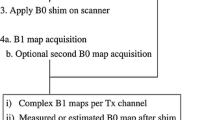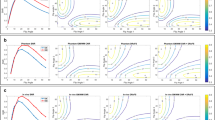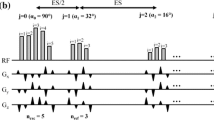Abstract
Object
Clinical 3 T MRI systems are rapidly increasing and MRI systems with a static field of 7 T or even more have been installed. The RF power deposition is proportional to the square of the static magnetic field strength and is characterized by the specific absorption rate (SAR). Therefore, there exist defined safety limits to avoid heating of the patient. Here, we describe a hybrid method to significantly reduce the SAR compared to a turbo-spin-echo (TSE) sequence.
Materials and methods
We investigate the potential benefits of a combined acquisition technique (CAT) for high-field neuroimaging at 3 and 7 T. The TSE/EPI CAT experiments were performed on volunteers and patients and compared with standard TSE and GRASE protocols. Problems and solutions regarding T2 weighted CAT imaging are discussed.
Results
We present in vivo images with T2 and proton density contrast obtained on 3 and 7 T with significant SAR reduction (up to 60 %) compared with standard TSE. Image quality is comparable to TSE but CAT shows fewer artifacts than a GRASE sequence.
Conclusion
CAT is a promising candidate for neuroimaging at high fields up to 7 T. The SAR reduction allows one to shorten the waiting time between two excitations or to image more slices thereby reducing the overall measurement time.








Similar content being viewed by others
References
Hennig J, Nauerth A, Friedburg H (1986) RARE imaging: a fast imaging method for clinical MR. Magn Reson Med 3(6):823–833
Hennig J (1988) Multiecho imaging sequences with low refocusing flip angles. JMR 78(3):397–407
Hennig J, Scheffler K (2001) Hyperechoes. Magn Reson Med 46(1):6–12
Hennig J, Weigel M, Scheffler K (2004) Calculation of flip angles for echo trains with predefined amplitudes with the extended phase graph (EPG)-algorithm: principles and applications to hyperecho and TRAPS sequences. Magn Reson Med 51(1):68–80
Weigel M, Hennig J (2006) Contrast behavior and relaxation effects of conventional and hyperecho-turbo spin echo sequences at 1.5 and 3 T. Magn Reson Med 55(4):826–835
Feinberg DA, Oshio K (1991) GRASE (gradient- and spin-echo) MR imaging: a new fast clinical imaging technique. Radiology 181(2):597–602
Hillenbrand C, Hahn D, Haase A, Jakob PM (2000) MR CAT scan: a modular approach for hybrid imaging. Magn Reson Mater Phy 10(3):183–199
Jakob PM, Hillenbrand CM, Kenn W, Hahn D, Haase A (2002) Abdominal imaging with a modular combination of spin and gradient echoes. Magn Reson Med 47(3):425–432
Mugler JP III, Brookeman JR (2004) Efficient spatially-selective single-slab 3D turbo-spin-echo imaging. In: Proceedings of the 12th scientific meeting, international society for magnetic resonance in medicine, Kyoto, p 695
Robson PM, Grant AK, Madhuranthakam AJ, Lattanzi R, Sodickson DK, McKenzie CA (2008) Comprehensive quantification of signal-to-noise ratio and g-factor for image-based and k-space-based parallel imaging reconstructions. Magn Reson Med 60(4):895–907
Choli M, Jakob PM, Loeffler RB, Hillenbrand CM (2010) Mixed-bandwidth acquisitions: signal-to-noise ratio and signal-to-noise efficiency. J Magn Reson Imaging 32(4):997–1002
Mugler JP III (1991) Potential degradation in image quality due to selective averaging of phase-encoding lines in Fourier transform MRI. Magn Reson Med 19(1):170–174
Henkelman RM, Hardy PA, Bishop JE, Poon CS, Plewes DB (1992) Why fat is bright in RARE and fast spin-echo imaging. J Magn Reson Imaging 2(5):533–540
Constable RT, Anderson AW, Zhong J, Gore JC (1992) Factors influencing contrast in fast spin-echo MR imaging. Magn Reson Imaging 10(4):497–511
Melki PS, Mulkern RV (1992) Magnetization transfer effects in multislice RARE sequences. Magn Reson Med 24(1):189–195
Mugler JP 3rd, Bao S, Mulkern RV, Guttmann CR, Robertson RL, Jolesz FA, Brookeman JR (2000) Optimized single-slab three-dimensional spin-echo MR imaging of the brain. Radiology 216(3):891–899
Busse RF, Hariharan H, Vu A, Brittain JH (2006) Fast spin echo sequences with very long echo trains: design of variable refocusing flip angle schedules and generation of clinical T2 contrast. Magn Reson Med 55(5):1030–1037
Pruessmann KP, Weiger M, Scheidegger MB, Boesiger P (1999) SENSE: sensitivity encoding for fast MRI. Magn Reson Med 42(5):952–962
Griswold MA, Jakob PM, Heidemann RM, Nittka M, Jellus V, Wang J, Kiefer B, Haase A (2002) Generalized autocalibrating partially parallel acquisitions (GRAPPA). Magn Reson Med 47(6):1202–1210
Griswold MA, Jakob PM, Chen Q, Goldfarb JW, Manning WJ, Edelman RR, Sodickson DK (1999) Resolution enhancement in single-shot imaging using simultaneous acquisition of spatial harmonics (SMASH). Magn Reson Med 41(6):1236–1245
Acknowledgments
The authors thank Melisa Okanovic for providing the GRASE sequence. This work was funded by the German Research Association (DFG JA 827/9-1). Technical support was supplied by Siemens Medical, Erlangen, Germany. We thank the Leibniz Institute for Neurobiology in Magdeburg for access to the 7 T.
Author information
Authors and Affiliations
Corresponding author
Rights and permissions
About this article
Cite this article
Choli, M., Blaimer, M., Breuer, F.A. et al. Combined acquisition technique (CAT) for high-field neuroimaging with reduced RF power. Magn Reson Mater Phy 26, 411–418 (2013). https://doi.org/10.1007/s10334-012-0362-3
Received:
Revised:
Accepted:
Published:
Issue Date:
DOI: https://doi.org/10.1007/s10334-012-0362-3




